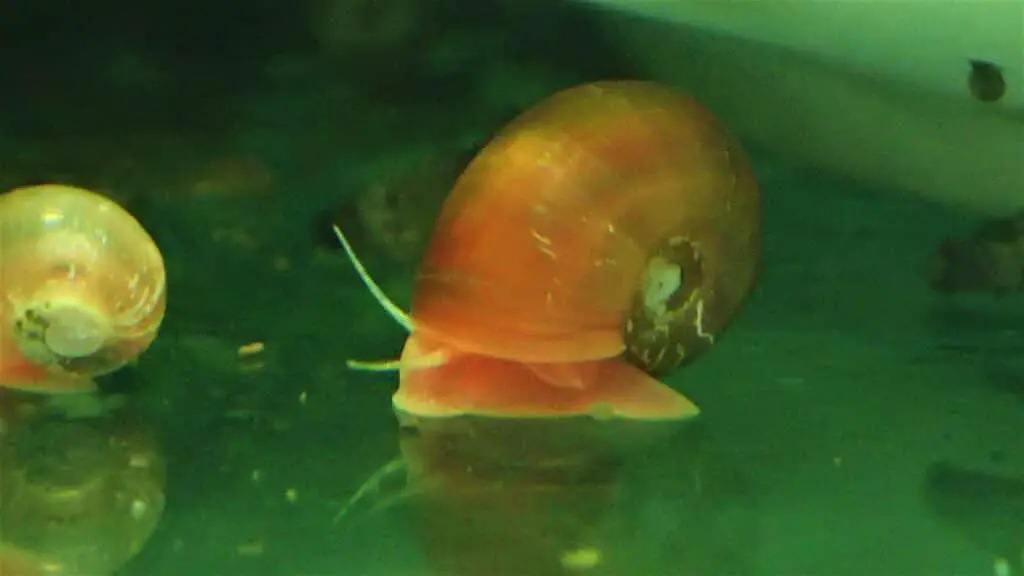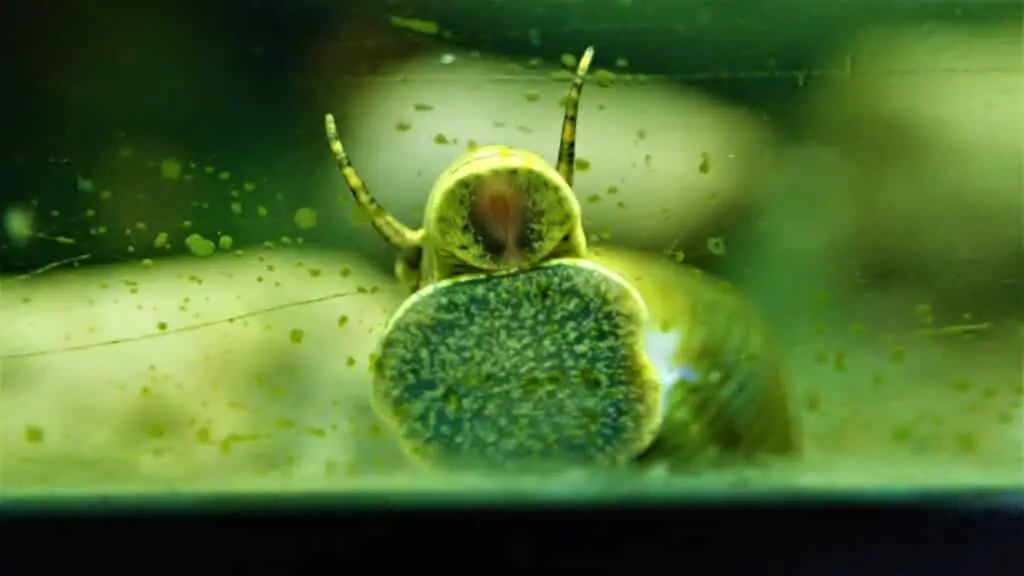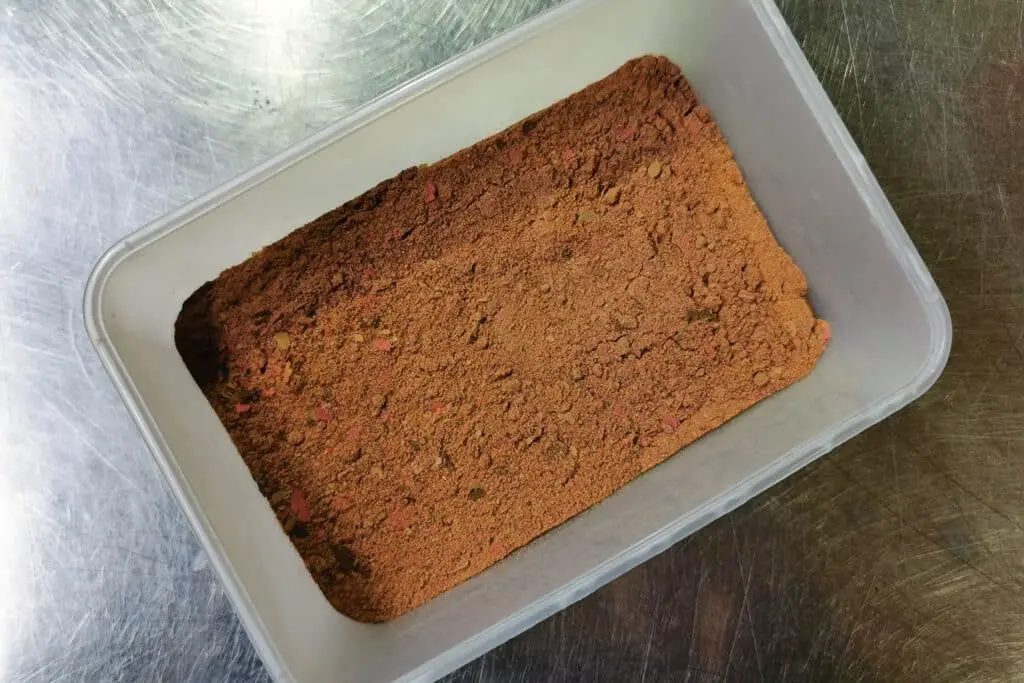Shrimp tanks have become increasingly popular in the world of aquascaping. These diminutive crustaceans bring color, activity, and charm to any aquarium.
To maintain a balanced, clean, and healthy shrimp tank, many aquarists introduce snails as tank companions. Snails not only serve as efficient tank cleaners but also create a more diverse and vibrant ecosystem.
However, not all snails are compatible with every shrimp tank setup. Different types of shrimp tanks have different water parameters and requirements, which dictate the ideal snail species to include.
Snails Types I Like To Use In My Tanks
This article will discuss the best snail species IMO and maybe a bonus snail or two – Malaysian Trumpet Snails, Ramshorn Snails, Bladder Snails, and Rabbit Snails – and their compatibility with various shrimp tank setups.

Malaysian Trumpet Snails (Melanoides tuberculata)
Ideal for: Softwater and hardwater shrimp tanks
Malaysian Trumpet Snails are a popular choice for shrimp tanks due to their hardiness, adaptability, and beneficial tank maintenance qualities.
These nocturnal creatures burrow through the substrate during the day, which helps aerate the substrate and prevents harmful gas pockets from forming. This is particularly useful for shrimp tanks with live plants, as it promotes root growth.
Pros:
- Adaptable to various water parameters
- Aerate the substrate
- Consume leftover food and decaying plant matter
- Breed at a manageable rate
Cons:
- Burrowing behavior may uproot delicate plants
- Can reproduce quickly in nutrient-rich environments

Ramshorn Snails (Planorbidae family)
Ideal for: Neutral To Hardwater shrimp tanks
Ramshorn Snails, named after the shape of their shells, are excellent algae eaters and can help maintain the cleanliness of your shrimps tank.
They thrive in neutral to hard water environments, making them perfect tankmates for shrimp species like the popular Neocaridina davidi.
Pros:
- Efficient algae eaters
- Attractive appearance
- Consume uneaten food and dead plant matter
Cons:
- Can reproduce rapidly under favorable conditions
- May consume delicate live plants if insufficient algae are available

Bladder Snails (Physidae family) Pond Snails
Ideal for: Softwater and hardwater shrimp tanks
Bladder Snails, also known as Pond Snails, are another popular choice for shrimp tank enthusiasts. These small snails are prolific algae eaters and contribute to keeping your tank clean.
They are hardy and can adapt to a range of water parameters, making them suitable for various shrimp tank setups.
Pros:
- Hardy and adaptable to different water parameters
- Effective algae eaters
- Consume leftover food and decaying plant matter
Cons:
- Rapid reproduction rates may lead to overpopulation
- Some aquarists consider them as pests due to their rapid breeding

Rabbit Snails (Tylomelania species)
Ideal for: Neutral To Hardwater shrimp tanks
Rabbit Snails, with their unique rabbit-like appearance, are an interesting addition to any shrimp tank. These snails prefer hard water environments and are suitable for Caridina shrimp species. Rabbit Snails are not known to breed as rapidly as other snail species, making them more manageable for aquarists.
Pros:
- Attractive and unique appearance
- Consume uneaten food and dead plant matter
- Slower reproduction rate compared to other snail species
Cons:
- Prefer hard water environments, limiting compatibility with some shrimp species
- May eat certain live plants

Nerite Snails (Neritina spp.)
Ideal for: 7ph and above, suitable for brackish water setups like Opea Ula Tanks.
Nerite Snails are an excellent addition to shrimp tanks, thanks to their attractive appearance and impressive algae-eating capabilities.
These snails are available in various patterns and colors, making them a visually appealing choice for aquarists. Nerite Snails are hardy and can adapt to a wide range of water parameters, making them compatible with various shrimp tank setups.
Pros:
- Highly efficient algae eaters
- Attractive appearance with various patterns and colors
- Adaptable to a wide range of water parameters
- Do not breed in freshwater, preventing overpopulation
Cons:
- May lay unsightly, hard-to-remove eggs in freshwater tanks
- Can climb out of the tank if not properly secured
- May require supplemental feeding if algae are scarce
Adding Nerite Snails to Your Shrimp Tank
Before introducing Nerite Snails to your shrimp tank, ensure that the water parameters are compatible and stable.
Acclimate the snails to the tank’s conditions by slowly introducing tank water to their container over a period of 30-60 minutes. This will help them adjust to the new environment and prevent shock.
Once acclimated, gently release the Nerite Snails into the tank, preferably near an algae-covered surface. Monitor their behavior and interactions with your shrimp and other tank inhabitants.
If necessary, provide supplemental feeding in the form of algae wafers, blanched vegetables, or other appropriate food sources.
By properly acclimating and monitoring these snails, you can enhance the beauty and balance of your shrimp tank while keeping algae growth under control.
The Benefits of Adding Snails to Shrimp Aquarium
Snails and shrimp can form a mutually beneficial relationship when housed together in a tank. Not only do snails help maintain cleanliness and balance within the ecosystem, but they also provide indirect nutritional benefits for the shrimp population.
Nutritional Benefits for Shrimp
One of the main advantages of adding snails to a shrimp tank is the unique nutritional relationship that forms between the two species. Shrimp tend to feed on snail waste, which primarily consists of plant and wood matter.
matter.
As snails consume algae, dead plant materials, and decaying wood, they break down these substances into smaller, more digestible particles for shrimp.
Shrimp have relatively short digestive tracts, which can make it difficult for them to efficiently break down and absorb nutrients from raw plant and wood matter. By consuming the pre-digested waste from snails, shrimp can access essential nutrients more easily, promoting their overall health and well-being.
Ecosystem Balance and Collaboration
The presence of snails in a shrimp tank helps establish a more balanced and efficient ecosystem. Snails and shrimp collaborate in maintaining tank cleanliness by consuming different types of waste materials.
While shrimp scavenge for leftover food and small particles, snails focus on consuming algae, dead plant materials, and decaying wood.
This collaboration reduces the need for additional chemical or mechanical interventions to maintain a clean and balanced tank environment. Snails also contribute to a more diverse and vibrant underwater landscape, creating a thriving ecosystem for both species.
In conclusion, adding snails to a shrimp tank offers several benefits that enhance the overall health, balance, and appearance of the aquatic environment.
The nutritional advantages provided by snails to shrimp, along with the collaborative efforts of both species in maintaining tank cleanliness, make them valuable additions to any shrimp tank setup.
Snail Care: The Importance of a Mineral-Rich Diet for Snails
Proper nutrition is crucial for maintaining the health and well-being of snails in a shrimp tank. A mineral-rich diet, in particular, plays a vital role in ensuring the development and maintenance of healthy shells.
Providing a diverse range of nutritious foods can significantly contribute to the overall health and longevity of your snail population.
Mineral-Rich Foods for Aquarium Snails
Snails require an adequate intake of calcium and other essential minerals to keep their shells strong and in good condition. A balanced diet that includes a variety of mineral-rich foods can help fulfill this need. Some recommended foods for snails include:
- Spinach: Spinach is a great source of calcium and other essential minerals, making it an excellent dietary choice for snails. Additionally, spinach contains high levels of vitamins A, C, and K, which contribute to overall snail health.
- Kale: Another calcium-rich leafy green, kale is an ideal option for snail nutrition. It also provides a range of vitamins, including A, C, and K, as well as antioxidants that help maintain snail health.
- Zucchini: Zucchini is a popular choice for snail feeding due to its high water content and nutritional value. Rich in minerals such as calcium and magnesium, zucchini supports shell development and overall health.
- Cuttlebone: Cuttlebone is an excellent calcium supplement that can be easily added to your snail’s diet. Simply break off a small piece and place it in the tank, allowing the snails to graze on it as needed.
Preparing and Feeding Mineral-Rich Foods
Before feeding any fresh vegetables to your snails, ensure they are thoroughly washed and, if possible, opt for organic produce to minimize exposure to pesticides.
Lightly blanching vegetables like spinach, kale, and zucchini can make them more palatable for snails and easier for them to consume.
Cut the vegetables into small pieces and place them in the tank using a feeding dish or a small rock to weigh them down. Remove any uneaten food after 24 hours to prevent it from decaying and affecting water quality.
A mineral-rich diet is essential for maintaining the health and shell condition of snails in your shrimp tank. Offering a variety of calcium-rich foods, such as spinach, kale, and zucchini, will promote snail well-being and contribute to a thriving aquatic environment.

Feeding Tip: Using Powdered Fish Flakes for Improved Snail and Shrimp Health
Proper nutrition is vital for maintaining the health and well-being of both snails and shrimp in your tank. A balanced diet can significantly impact the overall condition of your aquatic pets, preventing issues like shell erosion in snails and the “white ring of death” in shrimp.
One effective feeding tip to enhance your tank’s health involves using powdered fish flakes.
Powdered Fish Flakes: A Nutritious Addition to the Diet
Powdered fish flakes offer an excellent source of nutrition for snails and shrimp alike. By adding these flakes to your tank, you can promote the growth of biofilm, a thin layer of microorganisms that forms on surfaces within the tank.
Biofilm is a natural and highly nutritious food source for shrimp and snails, providing essential nutrients for their growth and well-being.
Benefits of Powdered Fish Flakes
- Improved Shrimp Health: The biofilm created by powdered fish flakes provides a valuable food source for shrimp, offering essential nutrients that can help prevent the “white ring of death.” This condition, caused by a sudden drop in molting hormones, can lead to shrimp mortality if not addressed.
- Healthy Snail Shells: A nutritious diet, including the minerals and vitamins found in powdered fish flakes, can contribute to the development and maintenance of strong, healthy shells in snails. This prevents shell erosion and ensures overall snail health.
- Enhanced Biofilm Growth: Powdered fish flakes promote the growth of biofilm on surfaces within the tank, providing a natural and nutritious food source for both snails and shrimp. This can help maintain a balanced, healthy ecosystem within the tank.
Using Powdered Fish Flakes in Your Tank
To incorporate powdered fish flakes into your tank’s feeding routine, sprinkle a small amount of the flakes onto the tank’s surface. The flakes will slowly sink and settle on various surfaces, promoting biofilm growth.
Monitor the consumption of the fish flakes by your tank inhabitants and adjust the feeding amounts as necessary to avoid overfeeding.
In using powdered fish flakes in your shrimp tank can offer numerous benefits for both snails and shrimp. By providing a nutrient-rich food source that promotes biofilm growth, you can ensure the health and well-being of your aquatic pets and maintain a balanced, thriving tank environment.

Warning: The Dangers of Overfeeding and Snail Population Control
While snails can be beneficial to your shrimp tank, it is crucial to monitor their population and avoid overfeeding. Overfeeding can result in a rapid increase in the snail population, which can lead to several problems within the tank, including water pollution and resource competition with your shrimp.
Strategies for Snail Population Control
- Monitor Feeding: Regularly assess the amount of food provided to your snails and shrimp. Ensure that you are not overfeeding them, as this can lead to rapid reproduction and overpopulation. Adjust feeding amounts and frequencies based on the needs of your tank inhabitants.
- Manual Removal: Periodically inspect your tank for snails and remove any excess individuals. This can help to manage the population and prevent overcrowding. Be cautious not to remove too many snails at once, as this could disrupt the balance within the tank.
It is essential to monitor the feeding and population of snails in your shrimp tank to avoid overpopulation and its potential negative impacts.
By implementing strategies to control snail numbers and ensuring proper feeding practices, you can maintain a balanced, healthy, and visually appealing shrimp tank environment.
Snail Types to Avoid in a Shrimp Tank IMO
While snails can be a beneficial addition to shrimp tanks, it is essential to choose the right snail species for your setup.
Some snail types may not be suitable for a shrimp tank, as they can cause harm to the plants or even the shrimp themselves. In this section, we will discuss two snail species that are not recommended for shrimp tanks: Marisa Snails and Assassin Snails.
Marisa Snails (Marisa cornuarietis)
Marisa Snails, also known as Giant Ramshorn Snails, are a large species of snail that can grow up to 2 inches in diameter. While their size and appearance may be visually striking, they are not an ideal choice for a planted shrimp tank.
Drawbacks of Marisa Snails:
- Plant Consumption: Marisa Snails are notorious for their voracious appetite for live plants. In a planted tank, they can cause significant damage by consuming various plant species, leaving a once lush aquatic landscape bare and unappealing.
- Tank Size Requirements: Due to their large size, Marisa Snails require a more spacious tank than smaller snail species. This may make them unsuitable for smaller shrimp tank setups.
Assassin Snails (Clea helena)
Assassin Snails are a carnivorous species known for their ability to control pest snail populations in aquariums. While they can be beneficial in certain situations, they are not the best choice for a shrimp tank.
Drawbacks of Assassin Snails:
- Predatory Behavior: Assassin Snails are known to prey on smaller snails and other invertebrates. In a shrimp tank, they may pose a threat to juvenile or weak shrimp, potentially causing harm or even death.
- Limited Algae Control: Unlike many other snail species, Assassin Snails do not consume algae, making them less effective in maintaining tank cleanliness and algae control.
Conclusion
Selecting the perfect snail companions for your shrimp tank requires a thorough understanding of the water parameters and needs of both your shrimp and snail species.
By considering the unique qualities and requirements of Malaysian Trumpet Snails, Ramshorn Snails, Bladder Snails, and Rabbit Snails, you can create a harmonious and balanced environment that promotes the health and well-being of your aquatic pets.
When introducing snails to your shrimp tank, start with a small number and monitor their behavior, reproduction rates, and impact on the tank’s cleanliness and balance.
Gradually adjust the snail population to achieve the desired results while avoiding overpopulation or unnecessary stress on your shrimp.
Choosing the right snail species for your shrimp tank is a matter of understanding their individual characteristics and compatibility with your shrimp’s water parameters.
By carefully selecting and managing your snail population, you can create a diverse and thriving ecosystem that is both visually appealing and beneficial for your aquatic pets.
FAQ
Q1: What factors should I consider when choosing snails for my shrimp tank?
A1: Consider the water parameters of your shrimp tank, compatibility between snail and shrimp species, snail reproduction rates, and the specific needs of your tank, such as algae control or substrate aeration.
Q2: Are snails safe for my shrimp tank?
A2: Generally, snails are safe and beneficial for shrimp tanks. However, it is important to choose compatible snail species that will not harm your shrimp or disrupt the tank’s balance.
Q3: How many snails should I add to my shrimp tank?
A3: Start by introducing a small number of snails and observe their impact on the tank’s cleanliness and balance. Gradually adjust the snail population to achieve the desired results without causing overpopulation or stress on your shrimp.
Q4: Will snails eat my live plants in the shrimp tank?
A4: Some snail species may consume delicate live plants if there is insufficient algae or food available. Be sure to research the feeding habits of the snail species you are considering before introducing them to your tank.
Q5: Can I keep multiple snail species in the same shrimp tank?
A5: It is possible to keep multiple snail species in the same shrimp tank, as long as their water parameter requirements are compatible and they do not compete for the same resources. Monitor their interactions and adjust the snail population if necessary.
Q6: How do I control snail population growth in my shrimp tank?
A6: To control snail population growth, limit the amount of available food by avoiding overfeeding your shrimp, remove excess snails manually, or introduce natural predators like assassin snails, which selectively prey on smaller snails.
Q7: How can I tell if a snail species is compatible with my shrimp tank’s water parameters?
A7: Research the specific water parameter requirements of the snail species you are considering and compare them with your shrimp tank’s parameters. Choose snail species with compatible needs to ensure a thriving and harmonious tank environment.
